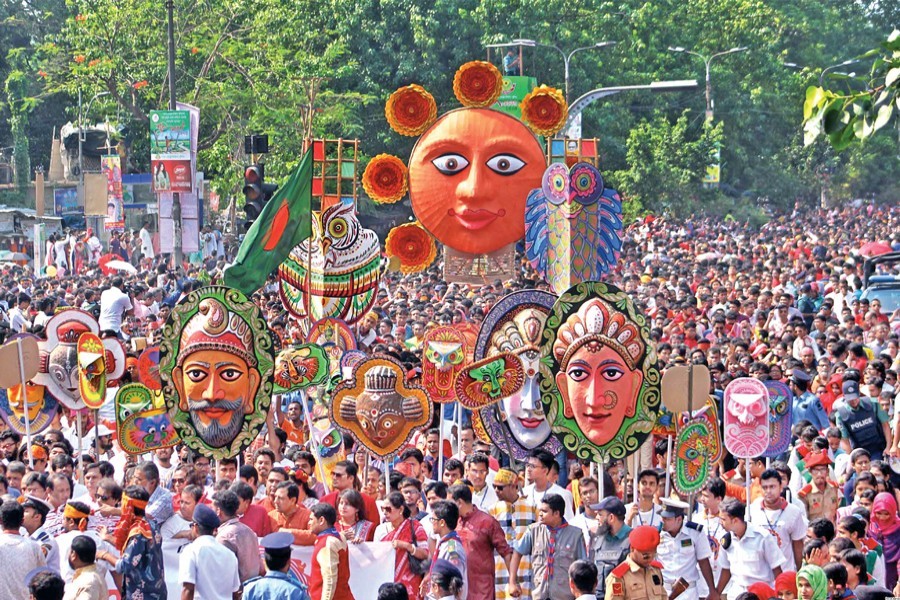
Published :
Updated :

Another year passed by. Another new start will be added to the Bengali date calendar, shoppers
will open a new Haalkhata. And so on. The preparations for Pohela Boishakh are now almost finished. Throughout all the heatwave and crumbled space for sweating, nature did not wait to start afresh. Raw mangoes and turbulent Kalboishakhi storms are also on their way.
With a historical journey, Anondo Shovajatra took the name of Mangal Shobhajatra after some years, but it feels like almost nothing changed on the way– neither the happiness nor the well wishes of the celebration of our Noboborsho (Bangla new year). Even not then, in the year of 2016 the Mongol Shobhajatra got included in UNESCO Intangible Cultural Heritage list. And how can we forget those companions who have never left our side while celebrating every new journey with colors and festivities? These motifs can also be called the vanguards of Pohela Boishakh. They are inanimate yet speak so loudly. They are an art form that is obviously connected with the charm of Pohela Boishakh. These are the structure of the occasion, the motifs of Pohela Boishakh.
When a thematic pattern recurs in the same type of decoration of cultural or literary forms– it can be taken as a motif. Thus the motifs of Pohela Boishakh revolve around mostly natural patterns such as animals, flowers, and the colors of nature.
Owls, elephants, fish, tigers, otters, birds and many animal face masks are one of the greatest attractions of an usual Pohela Boishakh celebration. No one can imagine a Shobhajatra rally without those vibrant and colorful masks. Not only in masks, but in other decorations too. But how are these connected? What message do they convey and what dimension do they add to this specific Bengali festival?
Rural melas are another biggest inspiration for these motifs. ‘Tepa Putul’ in human or animal shape is another recurring motif of the festival. It represents our age-old traditions of rural carnivals or ‘mela’s where local artists make dolls for the children gang. Though it now also holds another dimension of urban home decor and not only the children like it. Just as Tepa Putul, colorful and differently shaped kites, painted earthen pots, masks carry the same vibe with them.
Humankind and the animal planet have lived on this earth for decades and throughout the shared journey, there might be a very distinguished division between them. But all of us share the same roof called sky. Nature does not discriminate between its own children. So it is a beautiful gesture when humans take other parts of nature along with them in the journey of a celebration. Every morning of a Pohela Boishakh, it is not only the Bengali people who carry out the culture but also the tigers-elephants, owls and fishes accompany the rally. A diversity in beauty represents an inclusive image of starting another year together. Regardless of the spirit, the motifs also carry out some specific meanings such as an Owl is taken as a symbol of goodwill; Peacock for the beauty and colorful liveliness of nature.
Nature is what is reflected again and again in a Noboborsho celebration. All of the parts brought together creates a harmony never to be changed yet every year to be enriched with some other additions. As for this year, the Fine Arts Institute decided to bring out some of the endangered species from our country like ‘Bon rui’. Last year they went with ‘Nilgai’, which is the largest antelope of the Asian continent and another endangered mammal, Bon rui.
As fast as we are moving forward, we are leaving some parts of us behind. Those parts are related with the provider nature around us and development of human life has a somewhat negative impact on the natural sides. Students of Fine Arts try to represent the message of preservation as well as with the celebration of Pohela Boishakh and that is how the motifs of this festival gives us a thought to nurture with. An ideology that can inspire us to be gentle with our nature in activities and not to forget the roots of our existence. How else will we keep ourselves engaged with the purification of our soul with every new leave, every new start– at the end of spring?


 For all latest news, follow The Financial Express Google News channel.
For all latest news, follow The Financial Express Google News channel.